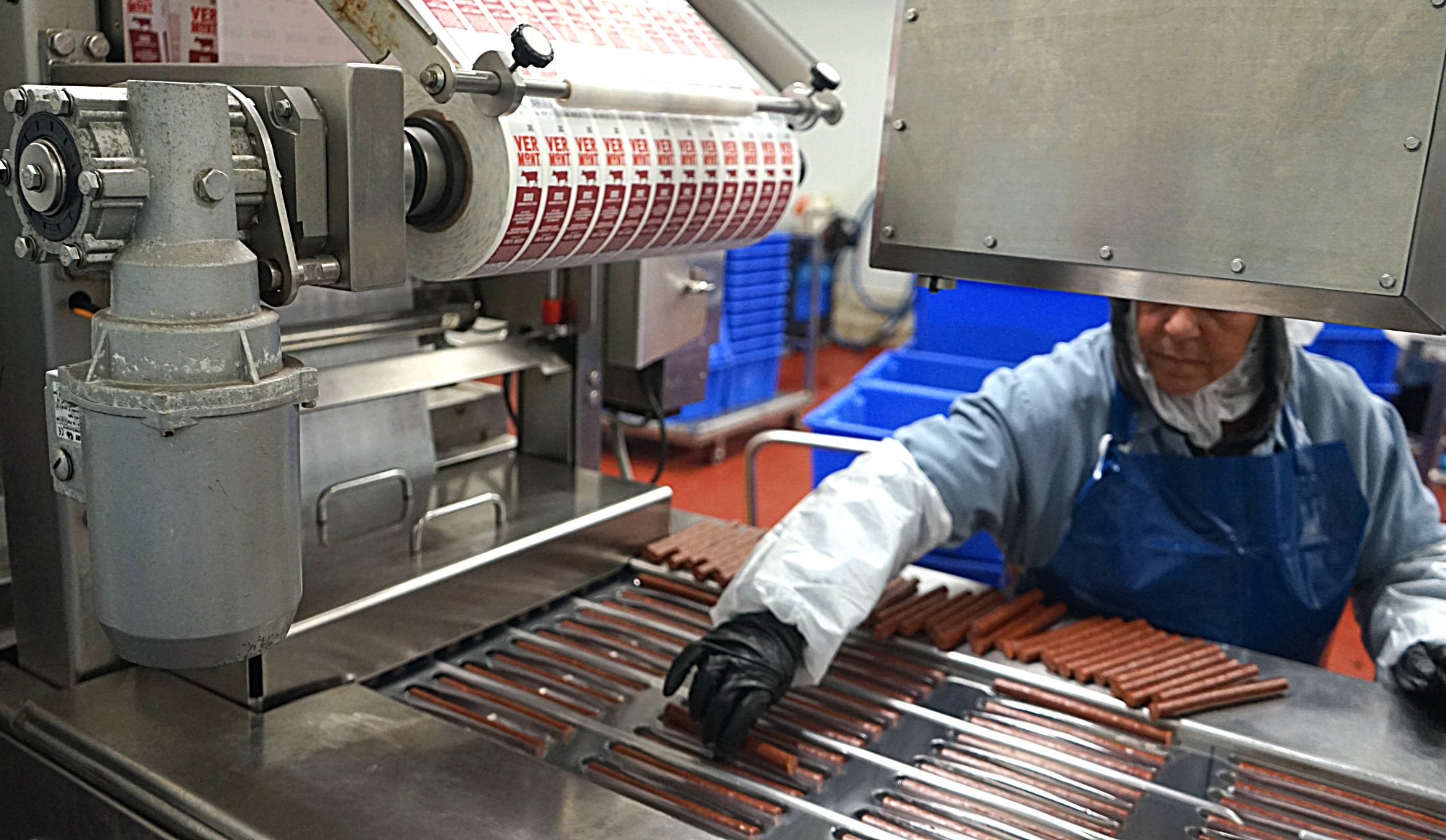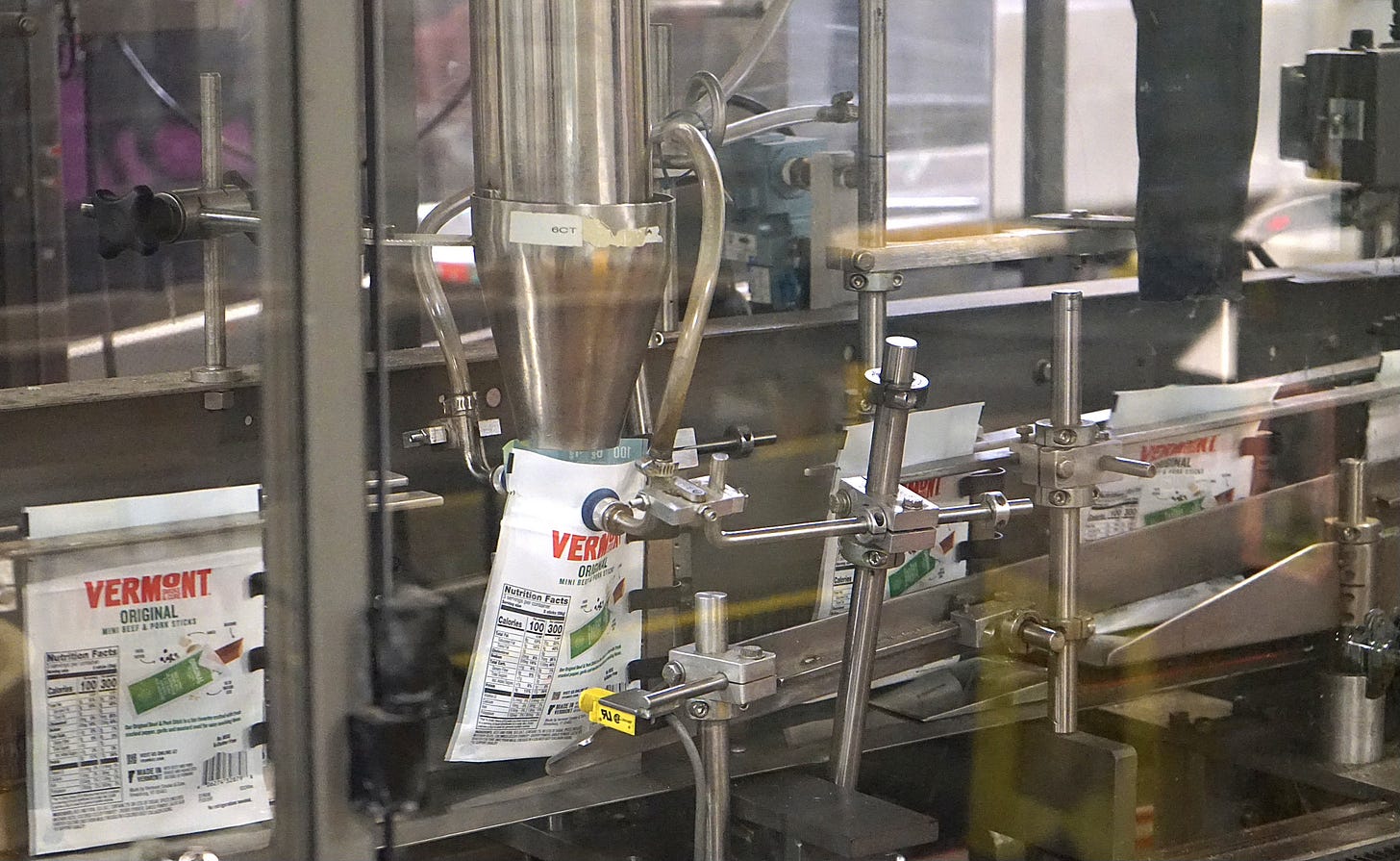VT Smoke & Cure Goes National
Hinesburg meat stick company gets major new contracts to sell its meat sticks across the country; hiring campaign underway.

By Geoffrey Gevalt
The Record Managing Editor
The door to Vermont Smoke & Cure is unassuming. A small raised-letter sign, a window on the door that looks into a small, darkened space with a counter but no human, a call box to the left of the door. Not a hint of what goes on inside.
Which is a bustle. Covering 30,000 square feet of space, the company is in motion — in the office and on the production floor where some 60 people each day take raw meat from as far away as Australia — all GMO-, hormone-, chemical- and antibiotic-free and then process it by grinding it up, adding spices, removing much of the meat’s moisture, lowering the PH, putting it into natural casings and then curing it with natural ingredients, smoking it, cutting it into 6- or 3-inch “sticks” and testing it for quality and safety and then packaging it, boxing it and shipping it to retailers, wholesalers and online customers.
Every day. Some 1.8 million pounds of it a year.
And within the next five years, the company expects production to nearly double … and they’re ready for it. All behind a little door in the old Cheese Factory building behind the Public House.
What’s more, they’ve had some big news these last two months. In April, the company announced a new contract with Costco that dramatically increases its presence to over 50 locations in New England. In May, Smoke & Cure announced new agreements with Walmart, Giant and Kroger in the largest growth in distribution in the company's history.
"This expansion across three major retail partners marks a transformative moment for Vermont Smoke & Cure," said Michael Schafer, the co-chief executive of the company. Transformational indeed. Schafer handles the business side of the business. Kristin Thayer, the other CEO, heads up operations.
The new agreement includes:
• 400 Walmart locations
• 1,000 Kroger stores
• 146 Giant stores
So it can now be said that Vermont Smoke & Cure is a national company. And it is planning to hire 12 new workers right now and it may also add a third shift to the daily schedule.
Vermont Smoke & Cure has been transforming itself for quite some time:
• Founded by a butcher in 1962 in South Barre, it was small-scale and local.
• In 2006, Chris Bailey, a farmer and chef, took it over, changed its name to Vermont Smoke & Cure and began modern production of meat sticks that were free of chemicals and hormones.
• In 2012, the company moved to Hinesburg. This was no small feat and required financing from Community National Bank, Vermont Economic Development Authority, VSJC Flexible Capital Fund and the landlord. The transition took nine months to settle in as it had to replace most of its workers (who couldn’t commute from Barre) and deal with normal hiccups of equipment and the new facility.
• In 2015, it changed its packaging and brand and began adding new flavors and sizes.
• In 2020 the company was sold to Johnsonville, LLC, a Wisconsin-based family-owned sausage-maker with a strong national presence. Vermont Smoke & Cure, however, operates as an autonomous subsidiary.
Cathie Weiner, head of marketing, and Chris McClain, operations manager — both Hinesburg residents — recently gave The Record a tour and a sit-down interview to talk about how the sticks are made, why the company is succeeding and how most of the people in town know little about the company and “have no idea we’re a national company.”
Describing the brand, Weiner is clear and direct about the standards the company adheres to in making its products:
• All meats are free of antibiotics, chemicals and added hormones.
• Only the best cuts of meat are used and are hand-trimmed and ground.
• No added sodium nitrites; only natural substances that have the same curative effect are used.
• No artificial colors, preservatives or flavors.
• Real spices like garlic, cracked pepper, and mustard seed.
• A natural fermenting process to lower pH, rather than adding encapsulated citrus or liquid acids.
• Ground hickory and maple wood shavings to smoke the meat sticks; no liquid or artificial smoke flavor.
• All products are free from MSG and major allergens (dairy, egg, gluten, fish, shellfish, tree nuts, peanuts & soy).
And, in an example of the values the company applies in its workplace, during The Record’s tour co-CEO Thayer was spied working alongside the other line workers in one of the packaging rooms, helping to make the switch from one product to another. “We all work on the line at some point or another,” McClain said.
The company’s new “tagline”—“For those who go further”—Weiner said, reflects the Vermont spirit of the company. What’s the concept behind that line? “We go further with everything that we do so that our customers can be energized and fueled by the protein to go further as well. They have the same mentality that we do. We’re all in. We don’t do things half-assed.”
So what role does the company’s owner, Johnsonville LLC, play in this? Vermont Smoke & Cure operates almost completely on its own, Weiner said. “Johnsonville provides great support in terms of research and development, training programs, inroads into larger retail distribution and on the supply side.” This has been particularly important, Weiner said. Both the covid epidemic and bird-flu worries were leaving Vermont Smoke & Cure with fewer and fewer options in terms of meat sources. Johnsonville helped expand their suppliers and cushion the company from disruptions in supply.
From Johnsonville’s perspective: “They had very strong interest in understanding the natural-snacking world.” Weiner said, “and they wanted to know how sticks work” — that is, the business of natural meat sticks — “and we helped launch their own stick line.”
Most important, she said. “They really want to protect everything we stand for — our values, sustainability and quality.”
Which makes a lot of business sense, too: Vermont Smoke & Cure ranks third in the nation in natural food snacks and its turkey meat sticks are the number-one seller in the northeast region.
Operations
As you would expect in any food production company, the place is clean. Very clean. Each room is hosed down and sanitized between each run. Full protective booties and garb are required in all rooms except final packaging.
McClain, who is involved in every aspect of the operations — from inspecting the farms that supply the meats to managing production and schedules, ensuring safety, maintaining the warehouse and distribution — has been with the company for 12 years. He loves what he does. And he is a fountain of information on every part of the plant, every machine and computer monitor as evidenced by the tour he led for The Record. Here are a few facts he shared:


• A federal inspector is on the premises for the start of every daily run; an internal inspection department randomly checks and analyzes each batch at various steps along the way.
• They do several runs in a day and try to keep it the same product, though sometimes they have to switch based on demand.
• The meat is taken from the coolers, trimmed and run through the grinder and then inserted into casings and draped over racks on wheels; each batch is numbered and some is removed at each step for testing.
• There is virtually no odor in the plant — except a little smoke; it’s actually pleasant and light. The company uses several low-temperature smokers and finely ground chips of maple and hickory that come in bags like chicken feed.
• The low-temperature smokers eventually raise the temperature of the hanging meat in any one of the three smoking rooms to about 180 degrees.
• When the product is ready, it’s put into a rapid-cooling room to bring temperatures down to federally required food-safety levels.
• At that point, the “sticks” are maybe six feet long and draped over the racks; they are then cut, wrapped and boxed and carted out to the warehouse for distribution.
During the tour, McClain pointed out the mechanization and computerization of the process that was watched closely by the workers. They keep an eye out for sticks cut too long or short, for packages that are too light (someone grabs the box, counts out the number of sticks and adds one or removes one), take the sticks rejected by length or as ends and cut them into proper lengths or toss them into a bin for reconstitution into the beginning grind or into another bin for sale to rendering houses.
“Very little is wasted,” McClain said.
Hiring
To do all this work and to meet the rise in demand, the company needs a strong base of loyal workers. Finding the latter is challenging as any Vermont employer knows these days.
Weiner is quick to point out the obstacles: High cost of housing, high cost of daycare and lack of public transportation.
Entry level jobs pay $19-$22 an hour; workers are provided with health insurance, sick-pay, parental leave and matches to 401k retirement plans. According to both McClain and Weiner, the hardest part for new employees is the first 30 days when they come to realize “that this is hard work.” In any food manufacturing job, McClain said, the process requires people to move fast and pay attention and work hard; the company has 10-hour shifts, four days a week.
But the company’s retention record after the first 30 days is pretty successful, they point out; its monthly average retention rate of 96 percent.
“I just wish there was more affordable housing in Hinesburg,” Weiner said. “That would make our recruitment task a lot easier.”
Nonetheless, the company is confident it can hire new workers, that it can keep them and that this next transformative phase of the company will work out well. They’ve been planning for it. And now it is here.





